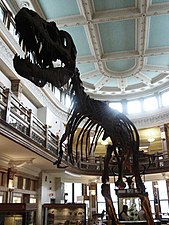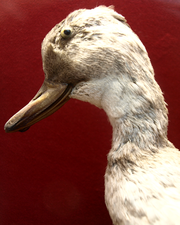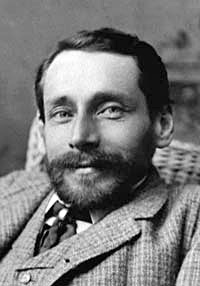
George Mercer Dawson was a Canadian geologist and surveyor. He performed many early explorations in western North America and compiled numerous records of the native peoples.

Opened in 1852, Mount Royal Cemetery is a 165-acre (67 ha) terraced cemetery on the north slope of Mount Royal in the borough of Outremont in Montreal, Quebec, Canada. Temple Emanu-El Cemetery, a Reform Judaism burial ground, is within the Mount Royal grounds. The burial ground shares the mountain with the much larger adjacent Roman Catholic cemetery, Notre Dame des Neiges Cemetery, and the Shaar Hashomayim Cemetery, an Ashkenazi Jewish cemetery. Mount Royal Cemetery is bordered on the southeast by Mount Royal Park, on the west by Notre-Dame-des-Neiges Cemetery, and on the north by Shaar Hashomayim Cemetery.
Walter Frederick Ferrier (1865–1950) was a Canadian geologist and mining engineer.

The Osler Library, a branch of the McGill University Library and part of ROAAr since 2016, is Canada's foremost scholarly resource for the history of medicine, and one of the most important libraries of its type in North America. It is located in the McIntyre Medical Sciences Building in Montreal.

Dawsonite is a mineral composed of sodium aluminium carbonate hydroxide, chemical formula NaAlCO3(OH)2. It crystallizes in the orthorhombic crystal system. It is not mined for ore. It was discovered in 1874 during the construction of the Redpath Museum in a feldspathic dike on the campus of McGill University on the Island of Montreal, Canada. It is named after geologist Sir John William Dawson (1820–1899).

The McCord Stewart Museum, formerly known as the McCord Museum of Canadian History, is a public research and teaching museum. The Museum’s Archives, Documentary Art, Dress, Fashion and Textiles, Indigenous Cultures, Material Culture and Photography collections, containing 2.5 million images, objects, documents and works of art, position it as the custodian of a remarkable historical heritage. It is located directly across the street from McGill University, in the downtown core of Montreal, Quebec, Canada.
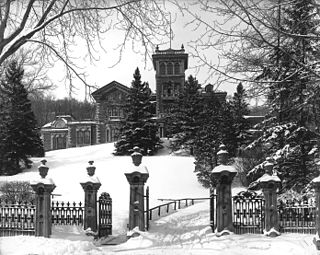
The Golden Square Mile, also known as the Square Mile, is the nostalgic name given to an urban neighbourhood developed principally between 1850 and 1930 at the foot of Mount Royal, in the west-central section of downtown Montreal in Quebec, Canada. The name 'Square Mile' has been used to refer to the area since the 1930s; prior to that, the neighbourhood was known as 'New Town' or 'Uptown'. The addition of 'Golden' was coined by Montreal journalist Charlie Lazarus, and the name has connections to contemporary real estate developments, as the historical delimitations of the Golden Square Mile overlap with Montreal's contemporary central business district.
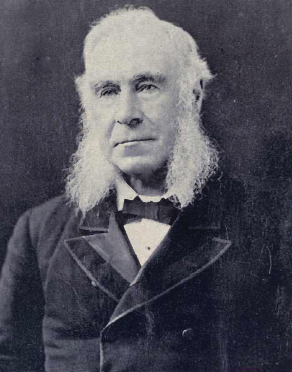
Peter Redpath was a Canadian businessman and philanthropist, closely associated with Redpath Sugar.
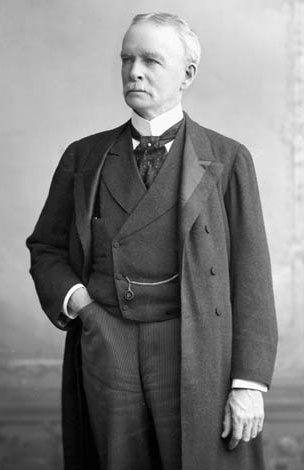
Sir George Alexander Drummond, was a Scottish-Canadian businessman and senator.
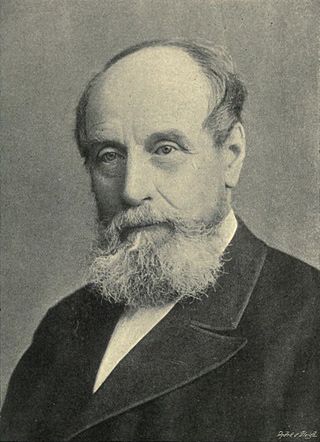
Sir John William Dawson (1820–1899) was a Canadian geologist and university administrator.
Thomas Henry Clark, Ph.D., FRSC was a Canadian geologist who is considered to have been one of the nation's top scientists of the 20th century. He was a professor who authored over 100 scientific publications. After his death, a mineral was named in his honour.

Sherbrooke Street is a major east–west artery and at 31.3 kilometres (19.4 mi) in length, is the second longest street on the Island of Montreal, Canada. The street begins in the town of Montreal West and ends on the extreme tip of the island in Pointe-aux-Trembles, intersecting Gouin Boulevard and joining up with Notre-Dame Street. East of Cavendish Boulevard this road is part of Quebec Route 138.
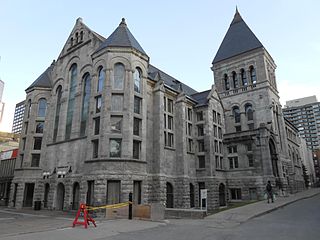
Redpath Hall is a historic building at 3461 McTavish Street in Montreal, Quebec, Canada, on the main campus of McGill University. It was originally the reading room of the Redpath Library, which opened in 1893 as McGill's first dedicated library building. During the first half of the 20th century, the library was extended several times to the south, and the expanded building became known as the Redpath Library Building. Subsequently, the adjacent McLennan Library Building was built between 1967 and 1969. Today, the Redpath-McLennan library complex houses the Humanities and Social Sciences Library, the largest branch of the McGill University Library.

McGill Street is a street in Montreal named after James McGill after whom McGill University is named. The former head office building of Canadian National Railway Company, built for its predecessor Grand Trunk Railway, still stands on McGill Street and is now occupied by Quebec government offices.
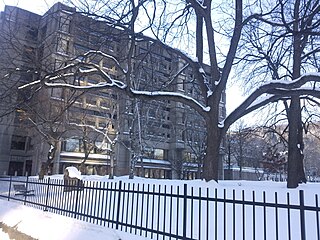
The McLennan Library Building is a major library building of McGill University in Montreal, Quebec, Canada. It is located at 3459 rue McTavish, at the northeast corner of rue Sherbrooke and McTavish. The building, along with the adjacent Redpath Library Building, currently houses the Humanities and Social Sciences Library, the largest branch of the McGill University Library.

The Roddick Gates, also known as the Roddick Memorial Gates, are monumental gates in Montreal that serve as the main entrance to the McGill University campus. They are located on Sherbrooke Street West and are at the northern end of the very short but broad McGill College Avenue, which starts at Place Ville Marie.

The McCall MacBain Arts Building is a landmark building located at 853 Sherbrooke Street West in Montreal, Quebec, in the centre of McGill University's downtown campus. The Arts Building is the oldest existing building on campus, and it was designed in the Classical Revival style by John Ostell. Construction began in 1839, and the building's central block and east wing were completed in 1843. The west and north wings were finished in 1861 and 1925, respectively, after involving multiple architects, including Alexander Francis Dunlop and Harold Lea Fetherstonhaugh. Today, the Arts Building is made up of a central block and three distinct wings – Dawson Hall (east), Molson Hall (west) and Moyse Hall (north). The building currently houses the Department of French Language and Literature, the Department of English, and the Department of Art History and Communication Studies. It also hosts lectures for several other departments from the Faculty of Arts.

The Macdonald-Harrington Building is a building located at 815 Sherbrooke Street West, on McGill University's downtown campus in Montreal, Quebec. Designed and built in Renaissance Revival style by Sir Andrew Taylor between 1896 and 1897, Macdonald-Harrington was one of the many donations made to the university by Sir William Macdonald. Today it houses the McGill School of Architecture and the School of Urban Planning, and prior to 1987, contained the Department of Metallurgy and Mining laboratories and the Department of Chemistry.
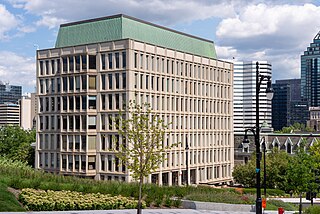
The Stephen Leacock Building, also known simply as the Leacock Building, is a building located at 855 Sherbrooke Street West, on the McGill University downtown campus in Montreal, Quebec. The building was named after Stephen Leacock, a well-known Canadian humorist and author, and Professor of Economics at McGill from 1901 to 1944. Built between 1962 and 1965 by the Montreal architectural firm Arcop, the Leacock Building's purpose was to accommodate the growing number of students at McGill, particularly in the Faculty of Arts which had outgrown its ancestral home, the Arts Building.

Henry Herbert Lyman was a Canadian businessman and amateur entomologist with an interest mainly in the butterflies. A member of a prominent family of industrialists who owned Canada's largest pharmaceutical company in its time, he and his wife were killed in the sinking of the RMS Empress of Ireland in 1914.




